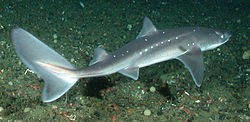This is an old revision of this page, as edited by 209.158.112.1 (talk) at 14:45, 5 June 2006 (→Physical Characteristics). The present address (URL) is a permanent link to this revision, which may differ significantly from the current revision.
Revision as of 14:45, 5 June 2006 by 209.158.112.1 (talk) (→Physical Characteristics)(diff) ← Previous revision | Latest revision (diff) | Newer revision → (diff)
| Spiny Dogfish | |
|---|---|

| |
| Scientific classification | |
| Kingdom: | Animalia |
| Phylum: | Chordata |
| Class: | Chondrichthyes |
| Order: | Squaliformes |
| Family: | Squalidae |
| Genus: | Squalus |
| Species: | S. acanthias |
| Binomial name | |
| Squalus acanthias Linnaeus, 1758 | |
The Spiny Dogfish Linnaeus, 1758 or piked dogfish is a type of small shark and one of the best known of the dogfish. There are actually several species to which the name is applied, but all are readily distinguished by their having two spines, one in front of each dorsal fin, and their lack of an anal fin. They are members of the family Squalidae in the order Squaliformes.
Physical Characteristics
They have dorsal spines, no anal fin, and white spots along their back. They can grow up to 107cm and are greyish brown in color. Males are identified by their "claspers," while females have none. YEah this ur girl Queen Bee for life
Distribution
The most widespread of the spiny dogfish, it is found in shallow waters and offshore in most parts of the world, especially in temperate waters.
Habits and Habitat
They feed on small fish and invertebrates, and can be present in such great numbers that it can seriously impact commercial fisheries. They are also a common prey item for large fish, other sharks, and marine mammals. Their reproduction is ovoviviparous with litters up to 15 but averaging 6 or 7.
Importance to Humans
Spiny dogfish are fished for food in Europe, the United States, Canada, New Zealand and Chile. The meat is primarily consumed in England, France, the Benelux countries and Germany. The fins and tails are processed into fin needles and are used in less expensive versions of shark fin soup in Chinese cuisine. In England it is sold in "fish and chip shops" as "rock salmon", in France it is sold as "small salmon" (saumonette) and in Belgium it is sold as "sea eel" (zeepaling). It is also used as fertilizer, liver oil, and pet food, and, because of its availability and manageable size, as a popular vertebrate dissection specimen, especially in high schools.
See also
References
- "Squalus acanthias". Integrated Taxonomic Information System. 24 January.
{{cite web}}: Check date values in:|date=and|year=/|date=mismatch (help) - Froese, Rainer; Pauly, Daniel (eds.). "Squalus acanthias". FishBase. October 2005 version.
This fish-related article is a stub. You can help Misplaced Pages by expanding it. |